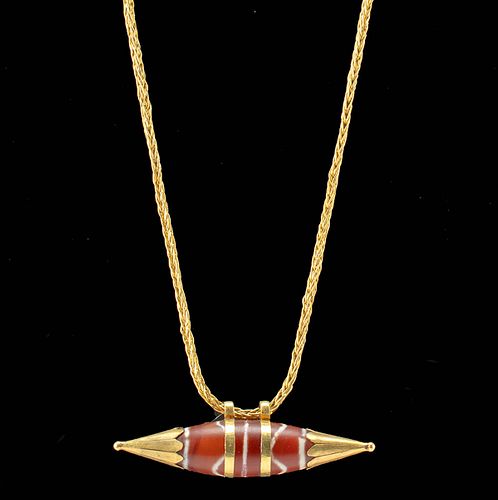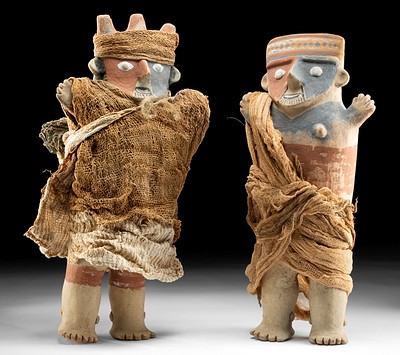Ancient Tibetan Chalcedony Dzi Bead on Gold Necklace
Lot 69b
About Seller
Artemis Fine Arts
686 S Taylor Ave, Ste 106
Louisville, CO 80027
United States
Selling antiquities, ancient and ethnographic art online since 1993, Artemis Gallery specializes in Classical Antiquities (Egyptian, Greek, Roman, Near Eastern), Asian, Pre-Columbian, African / Tribal / Oceanographic art. Our extensive inventory includes pottery, stone, metal, wood, glass and textil...Read more
Categories
Estimate:
$8,000 - $12,000
Absentee vs Live bid
Two ways to bid:
- Leave a max absentee bid and the platform will bid on your behalf up to your maximum bid during the live auction.
- Bid live during the auction and your bids will be submitted real-time to the auctioneer.
Bid Increments
| Price | Bid Increment |
|---|---|
| $0 | $25 |
| $300 | $50 |
| $1,000 | $100 |
| $2,000 | $250 |
| $5,000 | $500 |
| $10,000 | $1,000 |
| $20,000 | $2,500 |
| $50,000 | $5,000 |
| $100,000 | $10,000 |
| $200,000 | $20,000 |
About Auction
By Artemis Fine Arts
May 19, 2022
Set Reminder
2022-05-19 10:00:00
2022-05-19 10:00:00
America/New_York
Bidsquare
Bidsquare : Fine Antiquities | Ethnographica | Fine Art
https://www.bidsquare.com/auctions/artemis-gallery/fine-antiquities-ethnographica-fine-art-9350
Featuring a very special collection of Fine Art from the Hollywood Hills, including Picasso & Rookwood ceramics! Also included are many fine examples of classical antiquities, ancient, and ethnographic art from cultures encompassing the globe. Artemis Fine Arts info@artemisfinearts.com
Featuring a very special collection of Fine Art from the Hollywood Hills, including Picasso & Rookwood ceramics! Also included are many fine examples of classical antiquities, ancient, and ethnographic art from cultures encompassing the globe. Artemis Fine Arts info@artemisfinearts.com
- Lot Description
Ancient Central Asia, Tibet, ca. 1st millennium BCE. A stunning chalcedony dZi (also Dzi) bead of ellipsoid form fit with a modern gold setting and strung on a braided gold strand with a lobster claw clasp to be wearable. Flanked by a pair of conical gold caps with undulating peripheries, the ancient bead boasts a glossy surface in a hue of carmine with natural banding in shades of jasper and burgundy. A series of 5 white striations wrap around the bead, alternating between straight and undulating, as the center band lies at the middle of the bead between a pair of gold rings that secure it to the necklace. Size (bead with gold caps): 2.5" L x 0.6" W (6.4 cm x 1.5 cm); (necklace): 19.9" L (50.5 cm); gold quality: 86.6% to 88.1% (equivalent to 20K+ to 21K+); total weight: 23.9 grams
According to Lois Sherr Durbin, "A black-and-white or brown bead of etched or treated agate, found in a limited variety of shapes but with a wide range of patterns, the dZi bead is revered in Tibet; it is considered a 'precious jewel of supernatural origin.' Few beads have provoked more scholarly controversy: their origin, method of manufacture, and even the precise definition of dZi beads is hotly debated. A prime reason for this is that Tibetan religious laws do not permit archeological excavations, so all information on them is from written, often vague descriptions and orally transmitted folktales. The mysterious and apparently ancient patterns found on most dZi beads suggest connections with the shamanism and sorcery of Tibet's pre-Buddhist, animist religion." ("The history of beads: from 100,000 B.C. to the present," New York: Abrams, 2008, page 211)
Many mythological stories serve as explanations of the origin of dZi beads. Some believe that dZi beads adorned the gods in ancient times, who then discarded them when they became blemished, which is why they are so seldom found in perfect condition. Others say that dZi beads were originally worm-like insects that became petrified with some relating that dZi were encountered in the high mountains by someone with especially good karma who managed to catch them, but they became petrified when defiled by human touch. Still, there are more stories of dZi being found in the horns of slaughtered animals or the dung of cattle. Regardless of their origin, the ancient beads are worn to protect their wearer from catastrophe and ward off evil spirits that may cause sickness and death.
This piece has been searched against the Art Loss Register database and has been cleared. The Art Loss Register maintains the world's largest database of stolen art, collectibles, and antiques.
Provenance: East Coast collection, New York Gallery, New York City, New York, USA, acquired before 2010
All items legal to buy/sell under U.S. Statute covering cultural patrimony Code 2600, CHAPTER 14, and are guaranteed to be as described or your money back.
A Certificate of Authenticity will accompany all winning bids.
PLEASE NOTE: Due to recent increases of shipments being seized by Australian & German customs (even for items with pre-UNESCO provenance), we will no longer ship most antiquities and ancient Chinese art to Australia & Germany. For categories of items that are acceptable to ship to Australia or Germany, please contact us directly or work with your local customs brokerage firm.
Display stands not described as included/custom in the item description are for photography purposes only and will not be included with the item upon shipping.
#159435Bead is ancient, but all gold is modern. Intact, excellent, and wearable with impressive remains of decoration on bead.Condition
- Shipping Info
-
All shipping is handled in-house for your convenience. Your invoice from Artemis Gallery will include shipping calculation instructions. If in doubt, please inquire BEFORE bidding for estimated shipping costs for individual items.
-
- Buyer's Premium



 EUR
EUR CAD
CAD AUD
AUD GBP
GBP MXN
MXN HKD
HKD CNY
CNY MYR
MYR SEK
SEK SGD
SGD CHF
CHF THB
THB














